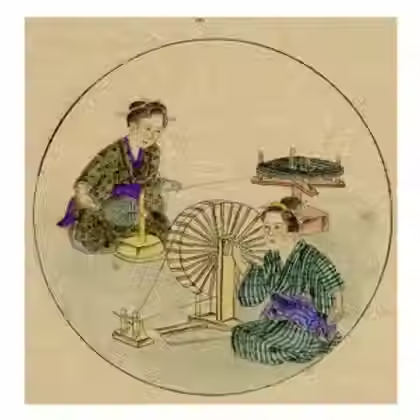Itoguruma Wheel
– Indonesia, Japan, Laos, Nepal, North Korea, South Korea
Japanese
Japanese wheels look a lot like Indian standing charkhras. The wheels were typically larger, and were designed for floor use rather than table use. The other difference is that the Indian charkhras have string “tires” while Japanese wheels have wooden ones. I'm not sure how else to better describe that. The part the drive band goes over is what I'm calling the “tire”, And I'm sure there's a word for it that I don't know. I’m calling them the Itoguruma wheel because they seem to originate in Japan and that’s the Japanese word for them.
Japanese women from the late 19th century spinning on a traditional Japanese wheel and reeling wheels. The design is a small souvenir painting of life in Japan.[1]
Indonesia
Indonesian spinning wheels are called ndatar or ndtaru.[2] The fancy ones would have one or sometimes two statues on them, usually representing Miala Ratu Nggela and Mamu Ratu Ngguku, the first human couple.[3] The ndatar have string wheels and are made to sit on the floor. They are very pretty.
A princess’s spinning wheel from Indonesia. Used more for ceremonial clothing than for industrial type use.[4] Super interesting figures, I’m hoping to find more!
Laos
Wheels made in Southern Laos often feature a naga or a river dragon head for protection.[5] The wheels are “hand operated”[6].
It’s Japanese? That’s so weird. I would have thought Indian, for sure…[7] Oh, it’s tilted too! I feel the need to try and feel the difference on my wheels
Nepal
Wheels in Nepal are very similar to those of Japan, with spoked wheels that are hand cranked.
A woman at her wheel, the drive band is a thread made of cotton, likely scrap from something else. The spindle isn’t really visible, but from what I can see, it’s almost full of thread.[8]
Korea
Wheels are called Mool Lae in Korean. Hand cranked wheels, designed to be used on the floor. Very similar to Japanese wheels.
A mool lae. This one is missing a spindle and drive band, but looks like it could easily be fixed.[9]





References
[1]Women Spinning Silk | etsy, accessed June 14, 2025, https://www.etsy.com/market/spinning_silk.
[2] Georges Breguet, “A Sumba Spinning Wheel: An Instrument, a Work of Art and a Lesson in Philosophy,” Art of the Ancestors, February 15, 2015, https://www.artoftheancestors.com/blog/sumba-spinning-wheel-georges-breguet.
[3] Ibid.
[4] Ibid.
[5] “Weaving of Laos,” Global InCH, accessed June 15, 2025, https://globalinch.org/craft/textiles-of-laos/.
[6] Ibid.
[7] Tammachat, Using a Traditional Lao Spinning Wheel, September 24, 2009, photograph, Flickr, September 24, 2009, https://www.flickr.com/photos/9255099@N08/3950237653.
[8] Jon G Fuller, “A Nepali Woman Spins Wool Thread with a Hand-Cranked Spinning Wheel in the Medieval Newari Village of Khokana, Nepal Stock Photo,” Alamy, April 5, 2013, https://www.alamy.com/a-nepali-woman-spins-wool-thread-with-a-hand-cranked-spinning-wheel-in-the-medieval-newari-village-of-khokana-nepal-image454084442.html.
[9] “Very Rare Korean Joseon Dynasty Wood Spinning Wheel ‘Mool Lae,’” eBay, accessed February 6, 2025, https://www.ebay.com/itm/151740507461.